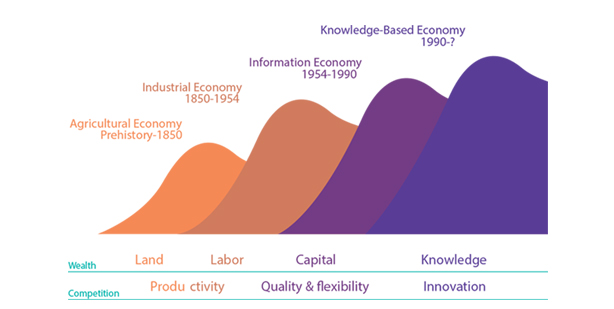The Sources of Wealth: From Productivity to Innovation
The Agricultural & Industrial based economy: Competition on Productivity
During the agricultural age, wealth was measured by the amount of land one possessed. With the beginning of automation in the industrial age, the source of wealth shifted from land to labor as the more employees that worked for a company, the more it could produce and the more it could improve its performance.
How efficiently and effectively an organization was able to manage its resources (productivity) then became the main source of competition.
The Information-based economy: Competition on Quality & Flexibility
During the information era, capital was the main indicator of wealth. Productivity was no longer sufficient, quality and flexibility were required for organizations to remain competitive. Over the past decade, we have entered into the knowledge-based economy, where knowledge has become one of the main assets of organizations.
The Knowledge-Based Economy: Competition on Innovation
The way that organizations are able to manage and leverage their intellectual capital to innovate has become a main strategic differentiator towards competitors and central to gain a sustainable advantage.
The 21st century is characterized by challenges that are unique in the history of humankind. Technological advances and social developments, together with a high level of interconnectedness due to globalization and collaborative technologies are dramatically changing world dynamics. Change is happening faster, in a more complex manner, and it occurs at a more profound level.
The future
Innovation through intrapreneurship has become imperative for most private firms but increasingly so in the public sector.
Therefore, capabilities in innovation management have become central to drive Business and Industry forward by both CEOs and governments alike. In today's more turbulent business environment, innovation involves the acquisition of external knowledge, advanced skills, and the application of new technological combinations. Consequently closer collaborations with customers, suppliers, complementors and even competitors are required.
Open innovation logics and collective strategies are vital for firms to gain a sustainable competitive advantage and to reinforce their market-place position. This context justifies the growing number of public-private partnerships (PPP) and the proliferation of business ecosystems.

Adapted from Savage, C. M. (1996). Fifth generation management : co-creating through virtual enterprising, dynamic teaming, and knowledge networking (Rev. ed.): Butterworth-Heinemann.



